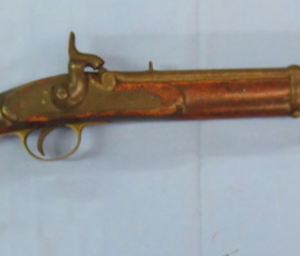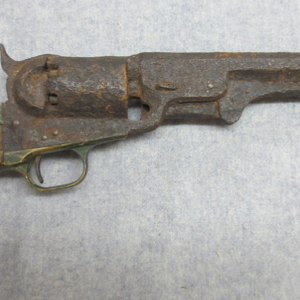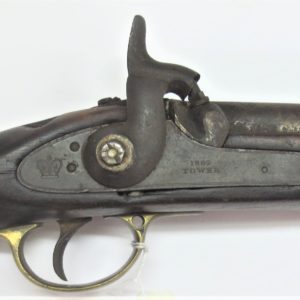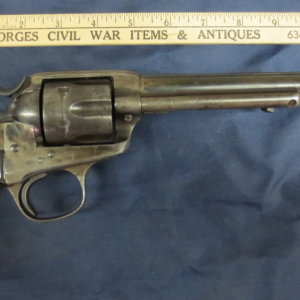Description
Tough example to find in nice condition, as this is a first year production of a weapon that saw extensive Civil War service from 1861 to 1865. For many years collectors called this type an “artillery” carbine as it had no provision for a saddle ring bar, but in reality the first examples produced did NOT have that assembly. Several thousand were sent back to have the bars and rings installed, but this one is honest as they come and fresh from an estate sale in western Virginia.
The serial number, 4169, places it as issued to the 2nd West Virginia Cavalry as documented examples include serial number 4168 and 4173 in the Springfield Research database. Condition is near fine overall and the weapon has generous amounts of original blue left, which has turned a pleasing plum brown patina. The wood stocks are excellent with no breaks. There is a wear gouge as you can see, likely caused by a mounted carbine sleeve. The bore is fine.
This single-shot, breechloading percussion firearm was extensively used by Federal mounted forces during the Civil War. Chambered in a hefty .50 caliber, the weapon was invented and patented by physician Gilbert Smith of Buttermilk Falls, New York in late 1855. The carbine measures 39½” long overall and weighs seven pounds and eight ounces. The wo piece walnut stock includes a 9” forearm held by a single barrel band. The clear outline of two government inspector cartouches are stamped at the left side of stock at the wrist area. The 28 5/8” long barrel is octagonal under the forearm and rounded forward of the barrel band. The barrel, receiver, hammer and butt plate all show consistent wear and use. There are traces of original casehardening near the nipple bolster and on the frame near the hammer. The original, folding single leaf rear sight with the “V” notch bar and a brass front sight is in place as it should be.
The left facet of the barrel breech shows US Government inspector marks of “L F R” and the left side of the frame above the sling bar is deeply stamped “ADDRESS / POULTNEY & TRIMBLE / BALTIMORE, U.S.A.” Below the bar are the patent markings “SMITH PATENT / JUNE 23, 1857” and “MANUFACTURED BY / AM’N M’CH’N WKS / SPRINGFIELD, MASS.” All stampings are clear and legible. The serial number (4169) is stamped on the bottom of the barrel / receiver hinge plate. This fine carbine exhibits strong mechanics and the bore is bright but could use a good cleaning. The frame screws not buggered or damaged as most are. The Smith carbines saw extensive service with the following cavalry regiments: 1st Massachusetts, 6th and 9th Ohio, 1st Connecticut, 7th and 17th PA, 7th and 11th Illinois and the 2nd and 3rd West Virginia Regiments. This is a very nice early War example of a primary Union cavalry arm of the American Civil War.
2nd Regiment, West Virginia Cavalry
OVERVIEW:
Organized at Parkersburg, W. Va., September to November, 1861. Attached to District of the Kanawha, W. Va., to March, 1862. Unattached, Kanawha Division, W. Va., to September, 1862. Unattached, District of the Kanawha, Dept. of the Ohio, to January, 1863. Unattached, 3rd Division, 8th Army Corps, Middle Department, to June, 1863. Scammon’s Division, W. Va., to December, 1863. 3rd Brigade, 3rd Division, Army of West Virginia, to April, 1864. 1st Brigade, 2nd Cavalry Division, Army of West Virginia, to June, 1864. 3rd Brigade, 2nd Cavalry Division, Army of West Virginia, to July, 1864. 2nd Brigade, 2nd Cavalry Division, W. Va., to November, 1864. 2nd Brigade, 2nd Division, Cavalry Corps, Middle Military Division, to February, 1865. 3rd Brigade, 3rd Division, Cavalry Corps, Army of the Potomac, to June, 1865.
SERVICE:
Ordered to Guyandotte, W. Va., December 15, 1861, and duty there till April, 1862. Co-operate with Garfield against Humphrey Marshall January 7-8, 1862. Dry Fork, Cheat River, February 8. 1st Battalion (Cos. “B,” “C,” “F,” “H” and “I”) moved to Meadow Bluff April, 1862. 2nd Battalion (Cos. “A,” “D,” “E,” “G” and “K”) moved to Raleigh with General Cox engaged in scouting and operating against bushwhackers in Raleigh, Fayette and Wyoming Counties till August, then rejoined Regiment. Demonstration on Virginia & Tennessee Railroad May 10-18. Lewisburg May 12. Princeton May 15-17. Retreat to Flat Top Mountain May 18. Jackson River Depot May 20. Lewisburg May 23. Raid to Shaver River May 30. Lewisburg May 30. Middle Creek June 8. Alderson’s Ferry June 9. Wolf Creek July 10. Lamb’s Mill July 15. Blue Sulphur Springs July 20. Alderson’s Ferry July 23. Williamsport July 28. At Meadow Bluff till August. Ordered to Kanawha Falls August 14. Shady Springs August 28 (Detachment). Campaign in Kanawha Valley September 6-16. Barboursville September 8. Fayetteville September 10. Cotton Hill September 11. Loop Creek September 11. Hurricane Bridge September 12. Charlestown September 13. At Point Pleasant to October 20. Moved to Charlestown October 20, thence to Camp Piatt. Expedition from Summerville to Cold Knob Mountain November 24-30. Lewis Mill on Sinking Creek November 26. Peters Mountain Raid January 5-20, 1863. Scout into Wyoming County February 5-8. Expedition into Pocahontas County February 10-12. Scout through Boone, Wyoming and Logan Counties March 12-16. Expedition through Logan and Cabell Counties April 3-6. Mud River April 5. Lewisburg May 2. West Union May 6. Summerville May 12 Fayetteville May 18-20. Scout on Big and Little Coal Rivers June 18-19. Loup Creek June 26 (Cos. “B” and “I”). Raleigh July 4. Expedition from Fayetteville to Wytheville July 13-25. Shady Springs July 14. Wytheville July 18-19. Fayetteville July 28. Cold Springs Gap August 5 (Detachment). Scouts from Camp Piatt September 11-13. Smythe County September 14. Scout to Boone Court House October 21-22. Expedition from Charlestown to Lewisburg November 3-13. Little Sewell Mountain November 6. Capture of Lewisburg November 7. Muddy Creek November 7. Near Union November 8. Scammon’s Demonstration from the Kanawha Valley December 8-25. Meadow Bluff December 11. Lewisburg and Greenbrier River December 12. Scout in Cabell and Wayne Counties March 16-18, 1864. Averill’s Raid on Virginia & Tennessee Railroad May 5-19. Princeton, Grassy Lick Cove, near Wytheville, Wytheville, Ingle and Cove Gap May 10. Salt Pond and Pond Mountain Gap May 13. Hunter’s Raid on Lynchburg, Va., May 26-July 1. Staunton June 8. Newport June 10. Lexington June 11. Near Buchanan June 13. New London June 16. Otter Creek June 16. Diamond Hill June 17. Lynchburg June 17-18. Liberty June 19. Buford’s Gap June 20. Catawba Mountains and near Salem June 21. Cove Gap June 23. Snicker’s Ferry July 17-18. Carter’s Farm July 20. Newtown July 22. Kernstown, Winchester, July 24. Martinsburg July 25. Hagerstown July 29. McConnellsburg, Pa., July 30. Hancock, Md., July 31. Near Moorefield August 7. Williamsport August 26. Martinsburg August 31. Bunker Hill September 2-3. Near Bunker Hill September 5. Near Stephenson’s Depot September 5. Darkesville September 10. Bunker Hill September 13. Near Berryville September 14. Battle of Winchester September 19. Fisher’s Hill September 22. Mt. Jackson September 23-24. Forest Hill or Timberville September 24. Piedmont September 25. Brown’s Gap September 26. Weyer’s Cave September 26-27. Battle of Cedar Creek October 19. Dry Run October 23. Nineveh November 12. Rude’s Hill, Front Royal, November 22. Expedition to Gordonsville December 19-28. Liberty Mills December 22. Jack’s Shop, near Gordonsville, December 23. Near Ashby’s Gap December 27. Sheridan’s Raid from Winchester February 25-March 25, 1865. Mt. Crawford February 28. Waynesboro March 2. Charlottesville March 3. Augusta Court House March 10. Haydensville March 12. Beaver Dam Station March 15. White House March 26. Appomattox Campaign March 28-April 9. Dinwiddie Court House March 29-31. Five Forks April 1. Namozine Church and Scott’s Corners April 2. Jettersville April 4. Sailor’s Creek April 6. Stony Point April 7. Appomattox Station April 8. Appomattox Court House April 9. Surrender of Lee and his army. Expedition to North Carolina April 23-29. March to Washington, D. C., May. Grand Review May 23. Mustered out June 30, 1865.
The regiment lost, during service, 4 Officers and 77 Enlisted men killed and mortally wounded and 115 enlisted men by disease. Total 196.








